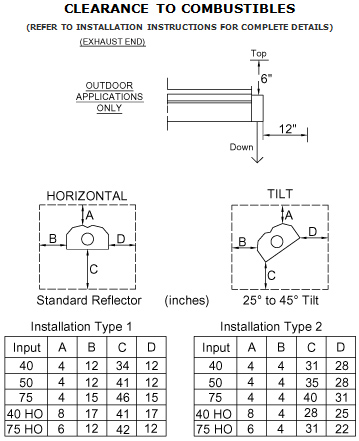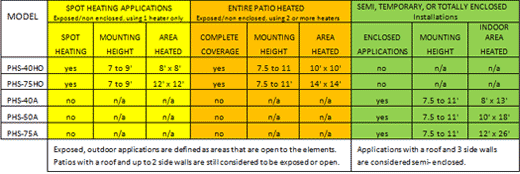Patio Heater Model Selection Guide
Selecting the correct size patio heater for your application is as easy as 1, 2, and 3 with the use of our Patio Heater Selection Guide. Just follow our three easy steps to assist you with your selection of the patio heater that best suits your needs.
Patio Heater Selection Guide
(See Details Section for more information to finalize your selection)
-
1) Decide which application best fits your needs.
For example, let's assume your application or installation requirement is for spot heating a specific area.
Locate the SPOT HEATING APPLICATIONS SECTION on the Patio Heater Selection Guide (follow area to section - see below).
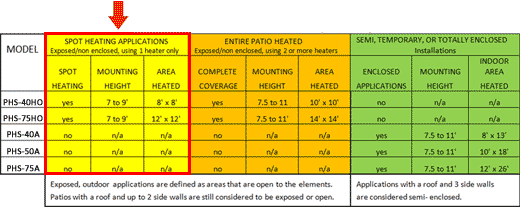
-
2) Select the amount of area to be heated
Let's assume the spot area to be heated is 12' x 12' (see red boxes below).
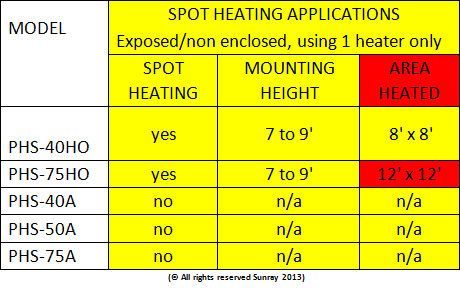
-
3) Select the model that best suits your installation and area
to be heated.The model that best suits this application or installation is the PHS-75HO,
(Blue highlighted box below)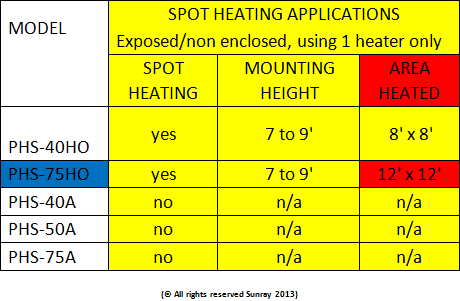
See how easy it is to select your heater? If you would like more information please read the Details Section below.
DETAILS SECTION
Wondering how we came up with our sizing chart?
See below for more details.
We welcome your questions so please don't hesitate to contact us at
1-800-778-6729 or questions@patioheaterusa.com
- 1) How much of the patio would you like to heat?
- a) Certain areas or spots heating?
- b) The entire patio?
- 2) What weather conditions may affect your area?
- a) Is it a windy location, cool breeze off the ocean?
- b) Well protected and very little wind.
- c) Low ambient temperature?
- 3) How much will the patio be used?
- a) Open spring, summer and fall; extension of season.
- b) Open year round with side curtains added in the winter.
- 4) Does the patio have any of the following?
- a) Trellis
- b) Roof, flat ceiling
- c) Roof, vaulted or peak inside, height of peak in inches:______"
- d) Roof, flat ceiling but recessed: amount of recess in inches:______"
- e) No overhead structure, but will build one for the heaters
- f) No overhead structure, units will have to wall mounted
-
5) Measure the dimensions of the area to be heated:
width x length x height (if roof or trellis)

- 6) Sketch out patio and note any features that may interfere with the
design such as trees or landscaping items or architectural features.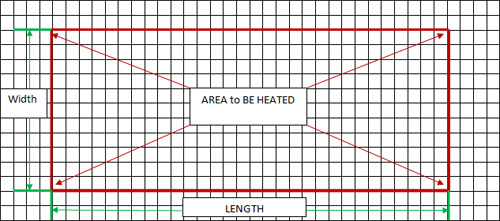
- 7) DETERMINE QUANTITY, MODEL and SIZE OF HEATERS FOR
YOUR PATIO:The two biggest variables that determine the model and quantity of heaters required for an application is wind and climate.
WIND: If your location has wind greater than 15 miles an hour, it is recommended that some form of wind protection be used to reduce the cooling effect of the wind.
CLIMATE: If your location has an ambient temperature below 50° F and you want the patio area to be comfortable, it is recommended to always use the largest model available and depending upon your location, you may be required to use multiple units to achieve the desired results.
Please note that the suggested installation heights and effective heated area (spread pattern) that we suggest in the following guide, are for average installations with wind below 15 mph and ambient temperatures of 50° F or higher. If your location does not match these conditions, you simply will need to add more heaters to achieve the desired results.
The Sunray heaters are the only heaters on the market that have a variable or modulating burner (patent pending) that can accommodate most installations. We have had great success in heating patios from the extreme conditions of Canada to the mild requirements of Mexico. The modulating burner allows you to use one heater for all your needs; from melting snow to providing a gentle blanket of warmth for your patio; one heater for all seasons at the turn of a dial. As compared to our competitors, they would have to use two or three of their units to achieve the same results that we can with just one unit. Please remember that you can always contact the factory directly and they will advise you of the model and units required for your particular installation.
For Open or exposed patios – Spot Heating or Entire Patio Heating (subsection a); we recommend using the HIGH OUTPUT SERIES or HO models for these applications. These heaters can be mounted from a ceiling or trellis, as well as from the side or wall of a building.
For Semi Enclosed, temporary enclosed (removable side curtains), or totally enclosed patios (subsection b), use the STANDARD A SERIES models. These units can also be mounted from the ceiling or the side or wall of a building. They have the option of utilizing a chimney or side wall venting system to safely expel the combustion by products from the space to be heated.
-
a) OPEN OR EXPOSED PATIOS THAT ARE GOING TO BE EITHER SPOT HEATED OR ENTIRELY HEATED:
(Note: if your installation is enclosed or semi enclosed refer to section 7 – b).
These applications require the highest amount of concentrated heat per sq. ft. The HO or HIGH OUTPUT Series is the best choice to use in this application. With its even heat output along the entire length, stainless steel construction and modulating gas valve, this unit is the most popular and versatile heater Sunray makes for outdoor patio heating. With this product, you have the choice of spot heating a particular space or warming an entire, exposed patio. Please note some exposed or open patios may have a roof but no side curtains or walls. They may also have an open trellis system. With respect to installations that have a roof, the following guidelines should be read prior to making your selection:
DO NOT INSTALL UNIT IN A RECESSED CAVITY. It is important to remember when mounting a heater overhead that it not be installed in a recessed cavity. This is best described as the heater being “recessed” into the ceiling. A heater installed in a recessed cavity can become
over-heated and cause damage to the unit as well as the surrounding structure.
IN A RECESS TRAY CEILING, (not to be confused with cavity) installation, the PH HO series, should not be installed unless the tray ceiling area has some form of ventilation to allow the products of combustion to escape from the confined area. The form of ventilation can be either a powered ventilator, or a ventilation grille sized and located to provide proper air flow or ventilation of the recessed space. If there is improper ventilation, the products of combustion may not dissipate at a fast enough rate to maintain clean combustion for the heater(s). This condition may cause the unit to operate incorrectly or shut down completely until the by-products have diluted sufficiently and may cause an unsafe condition. However, as an alternative, the PHS-A Series can utilize a chimney system to expel the by-products of combustion from the area. If you have any questions about Sunray Patio Heater applications, please don’t hesitate to ask call 1-800-778-6729 or e-mail us at: questions@sunraypatioheaters.com
Please remember that heating outside where there are no walls is challenging, and it is important to have sufficient capacity. If wind conditions are significant, wind breaks and extra heaters may be required to provide a comfortable environment. If there is a concern that there may be “too much heat”, all PH models come with proprietary, variable capacity controller is so the heat level can be turned down when maximum heat output is not needed.
CLEARANCE TO COMBUSTIBLE MATERIALS: When selecting the unit(s) for your applications, always remember to observe the clearances required to combustible material for each model to ensure a safe installation. (See clearance to combustible material section and installation manual)
SPOT HEATING APPLICATIONS – SINGLE UNIT INSTALLATIONS: (For heating a specific area such as a smoking area, a table, or sitting area). Start by measuring the area to be heated (width x length). Then see the illustration below and select the model that best suits your need.
For example, if the area to be spot heated is 7' x 6' select the model PHS-40HO unit since it has a heated area or spread pattern of 8' x 8' and will have enough coverage for the application. Select model and size of unit according to application and heat spread pattern. Calculate the number of units required according to the application and dimensions of spread pattern for the given application for the area to be heated.
SPOT HEATING: Area Heated (coverage or spread pattern) by a particular unit.
RECOMMEND MOUNTING HEIGHT: 7' to 9' Note: The higher the mounting height, the less intense the heat will be. If it necessary to install the heater at an elevation higher than 9', it may be necessary to select the next larger heater or use two heaters. In these situations, simply contact the factory for further information and options available for your application. In weather conditions that are breezy or low ambient temperatures; mount the heaters at a lower elevation in order to concentrate the heat onto the particular area requiring heat.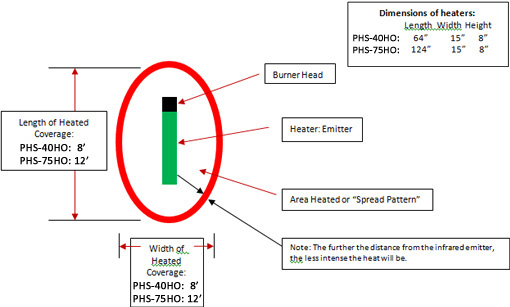
SPOT HEATING APPLICATIONS - MULTIPLE UNIT INSTALLATIONS: Using the dimensions of the spread pattern in the diagram above for each unit, select the heater you require and locate the heaters above each area that requires spot heating .
ENTIRE PATIO HEATING APPLICATIONS: The entire patio area can be heated with multiple units. When using multiple units, the heaters are installed with their spread patterns overlapping. In this type of installation, there is a cumulative effect from the overlapping of the spread patterns which increases the size of the area heated by the heater.
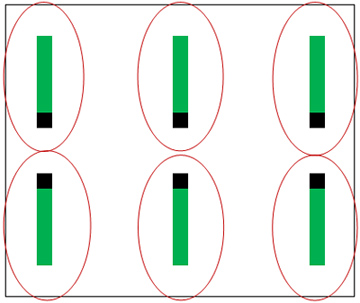
To determine the correct unit and quantity, start by measuring the area to be heated (width x length). Determine the number of heaters required according to their associated spread patterns (See illustration below and review the spread pattern associated with each heater). It is usually more economical to select the largest unit possible. The reason for this is there will be less heaters to install thereby reducing the installation and equipment cost as compared to expense associated with the installation of “many small units”.
For example, if the patio area is 28’ wide x 42’ long, select the PHS-75HO unit based upon the spread pattern associated with the unit,and in this example, use 8 units. To locate the units correctly on the patio, see the diagram titled “Entire Patio Heating Layout Example” for positioning of the heaters. Please note that positioning or layout of heaters is subject to the weather conditions where the patio is located. In cooler locations and breezy situations, space the heaters closer. For average conditions, the heaters can be farther apart.
ENTIRE PATIO HEATING: Area Heated (coverage or spread pattern) by a particular unit.
Suggested Mounting Height: 7.5’ to 11’
Heat spread pattern per unit when 2 or more units are used in this type of installation.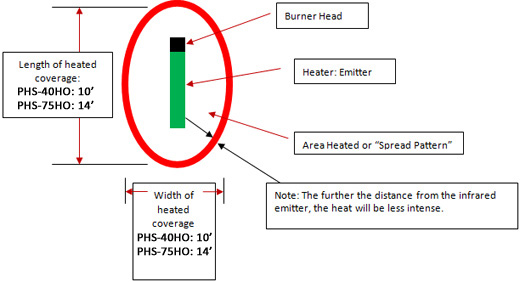
Entire Patio Heating Layout Example:
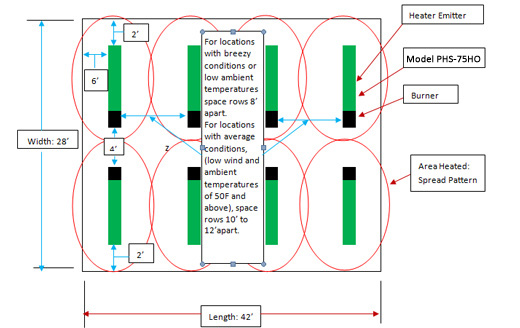
- b) SEMI ENCLOSED, TEMORARILY ENCLOSED (removable side curtains) or TOTALLY ENCLOSED PATIOS:
The standard A Series is the best choice for these applications. The heaters in this series can be connected to either a roof chimney or side wall vent that will safely exhaust the by- products of combustions from the area being heated. Please note that enclosed patios require less heat because they usually have some form of barrier (side curtains, roof) to help contain the heat in a given area.
- Designed primarily for use in enclosed or semi-enclosed areas; patios with recessed ceilings that prevent the escape of combustion by products; or patios that will be using side curtains during the winter months for year round use. Depending upon application, these units can be either unvented or vented. Vented is defined as using a chimney.
- Heat output varies from burner end (hot) to exhaust port (cooler) and it is advised to take this into consideration when selecting a unit from this series. For assistance please don’t hesitate to call us for further information.
- Very low clearance to combustible materials
- Modulating burner and remotely located control panel allows the user to adjust heat capacity, according to comfort requirements. In entirely enclosed applications, a thermostat can also be used to control the temperature inside the space that is being heated.
Example of the heat spread pattern for a PHS-A-Series unit.
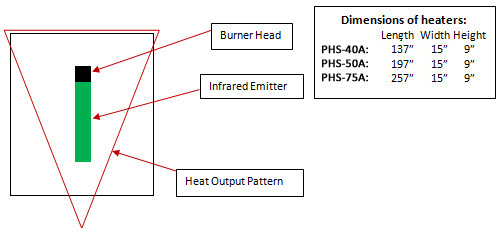
Note to achieve even heat coverage, it is best to use multiple units with the heaters parallel to each other, separated by 8 to 14' and with the burner heads on opposite ends.
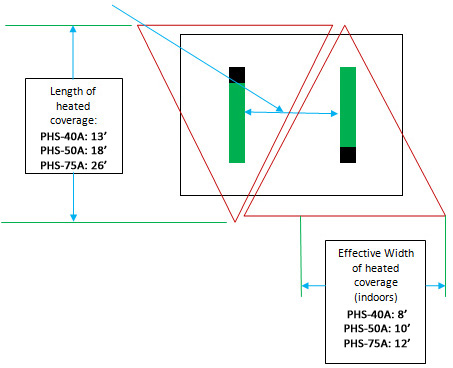
To select the model and size of unit, follow the suggested rational used in section 7 -a) and apply it to your semi enclosed or totally enclosed application. In other words, take into consideration the area to be heated, the heat spread pattern and calculate the number of units for your application. If you have any questions, please feel free to give us a call and we would be happy to assist you with your selection.
- 8) CLEARANCE TO COMBUSTIBLE MATERIALS:
-
Once you have decided on the model and size of heaters for your application, refer to the clearance to combustible dimensions below to confirm they can be installed safely at your patio. If you have any questions, please don't hesitate to call us and we'll assist you with this process.
